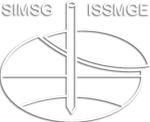Calibration and limitations of a fixed-partly fixed resonant column apparatus
Calibration and limitations of a fixed-partly fixed resonant column apparatus
The small-strain shear modulus of soils and rocks is an important input parameter in geotechnical analyses. Its estimation using the resonant column apparatus relies on accurate knowledge of the rotational inertia of the apparatuss active end. Due to the complex geometry of the active end, its inertia is typically found from a calibration exercise. In this study a range of aluminium calibration bars and steel masses were used to compare two different calibration exercises presented in the literature. The resulting values of active end inertia are shown to be highly method-dependent. The method of compensating for the drive connection stiffness by finding the apparatus resonant frequency is found to introduce errors at low stiffness. The combined use of calibration bars and masses reduces scatter but yields poor results for stiff bars. An alternative approach to mitigate both of these problems is suggested. Active end inertia is found to be constant using this alternative approach. While effects of base inertia and reaction mass inertia are found to be small for this apparatus, compliance of the drive system is shown to significantly reduce resonant frequencies at high stiffnesses which increases the apparent active end inertia. This reduction in resonant frequency is modelled and used to derive frequency correction factors, which reduce errors in shear modulus to within acceptable limits when using the constant value of active end inertia. This demonstrates the potential for increasing the limit of sample stiffness where sufficient calibration data are available.
Luke Rieman; Roisin M. Buckley; S. J. Wheeler
8th International Symposium on Deformation Characteristics of Geomaterials (ISDCG2023)
I.1) Advances in laboratory testing techniques (equipment and procedures)
